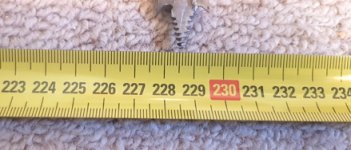DeformedTree
Member
- Joined
- May 19, 2018
- Messages
- 1,341
six-point socket II said:I hear what you say about "cm" and I can even see the "problem" you're addressing - but to be honest, for native metric users, it simply isn't one. It is done/used every day like that. And the process of simply changing the decimal dot feels/is natural.
Everything above 1m would mean a 4 figure number in mm. That's not really practical to work with (at those lengths), that's why cm are used. And it's the same vice versa: a 12 mm drill bit "makes more sense" than a 1.2 cm drill bit. It just "naturally grew/ evolved"
But I guess it all comes down to what you are truly used to. I bought myself a tape measure that has a metric and fractional scale, just to better understand FOG posts when fractional measurements are used, to get a "feel" for it, so to speak. And I'm sure, if I started to do projects with inches/fractional measurements, I'd make the same mistakes.
Kind regards,
Oliver
So while you aren't wrong if you grew up using cm and mm back and forth, as as been brought up in other threads, even in metric countries, usage of cm is limited. From working with folks around the world, and some comments here, it's understood there is some heavy cm usage in northern parts of continental Europe (parts of Germany, lands to the northwest), else where they aren't used, and those folks have the same issues and grew up metric.
I use metric in my professional carrier, we do it all in mm, there is no cm. Going over 1m in mm is not a issue. You would have to hit 10m before a discussion of this would even come up. Not many things get that big, and if you did, you would just use meters. But calling out say 2125mm on a print is perfectly normal. It's also how drawing standards and dimensional control standards work. If metric, you use mm, if inch, you use inches. I have worked with many people/companies from many European Countries, haven't seen a cm yet.
Around my house, when doing stuff in metric, i do it in mm, have done wall framing in it just fine. Cutting a stud to 2286mm, not problem, no way in heck would I try doing 228.6cm 2286 is just so much easier to think than 228.6
The real core issue is simply why tape measures a generally in cm? I've looked into ordering some from other countries just to get mm ones. It's not like you find inch tape measures that are in yards (yes they do in fact exist in some niches), sure it's a unit that exist, but outside of sports we don't use it. Tapes marked out with cm, is like finding tape measures in yards instead of feet/inch.


